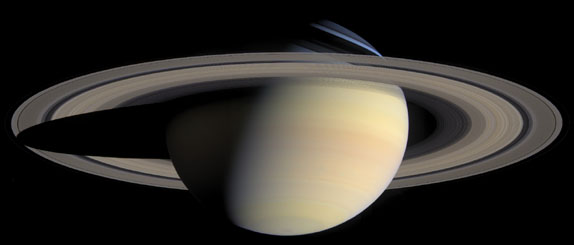
The Repulsion Force Affects Inner Saturn's Rings
Scientist
baffled about the movement of the D ring inwards 125 miles and the lower
intensity of light reflecting off of the rings are looking for answers. Again
conventional theories fail to provide an adequate explanation of events
presently occurring in the cosmos.
The repulsion force, long a rumor or subject that has no credentials in present-day influential scientific circles on Earth is now giving subtle hints that there are many unknowns in the universe that should be considered. As the rogue 12th planet shrouded in a dust cloud of invisibility to the general population as it moves upward into the ecliptic plane, the repulsion force exerts a force on all objects by pushing out the total system and reducing the space of all objects contained within the system. So a movement of the total system within the last 2 years contrary to estimates of 25 years would reduce reflectivity due to incremental increases in overall distance and within the system compression of the internal rings.
All
Rights Reserved: © Copyright 2005
| LOS ANGELES, California (AP) -- New observations by the international Cassini spacecraft reveal that Saturn's trademark shimmering rings, which have dazzled astronomers since Galileo's time, have dramatically changed over just the past 25 years. |  |
| Scientists are interested in Saturn's rings because they are a model of the disk of gas and dust that initially surrounded the sun. |
Among the most surprising findings is that parts of Saturn's innermost ring -- the D ring -- have grown dimmer since the Voyager spacecraft flew by the planet in 1981, and a piece of the D ring has moved 125 miles inward toward Saturn.
While scientists puzzle over what caused the changes, their observations could reveal something about the age and lifetime of the rings.
Cassini-related discoveries were discussed Monday at a meeting of the American Astronomical Society's division of planetary sciences in Cambridge, England.
"I don't think Saturn's rings will disappear anytime soon, but this tells us how the rings are evolving and how long they might last, " deputy project scientist Linda Spilker said in a telephone interview from England.
Scientists are interested in Saturn's rings because they are a model of the disk of gas and dust that initially surrounded the sun.
Studying them could yield important clues about how the planets formed from that disc 4.5 billion years ago.
The ring observations were made this summer.
The $3.3 billion Cassini mission, funded by NASA and the European and Italian space agencies, was launched in 1997.
Cassini is managed by NASA's Jet Propulsion Laboratory in Pasadena.
Copyright 2005 The Associated Press. All rights reserved
This material may not be published, broadcast, rewritten, or redistributed.
Story Courtesy of CNN
http://www.cnn.com/2005/TECH/space/09/06/saturn/rings.ap/index.html